
Guildford is a town in west Surrey, England, around 27 mi (43 km) south-west of central London. As of the 2011 census, the town has a population of about 77,000 and is the seat of the wider Borough of Guildford, which had around 143,929 inhabitants in mid-2019 est. The name "Guildford" is thought to derive from a crossing of the River Wey, a tributary of the River Thames that flows through the town centre.
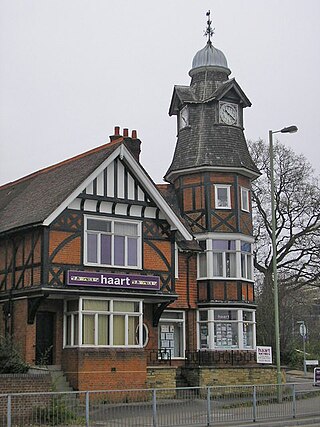
Farnborough is a town in northeast Hampshire, England, part of the borough of Rushmoor and the Farnborough/Aldershot Built-up Area. Farnborough was founded in Saxon times and is mentioned in the Domesday Book of 1086. The name is formed from Ferneberga which means "fern hill". According to the UK-wide 2011 Census, the population of Farnborough is 57,486.
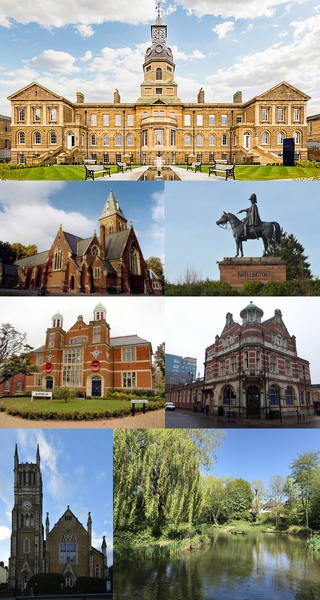
Aldershot is a town in Hampshire, England. It lies on heathland in the extreme north-east corner of the county, 31 mi (50 km) south-west of London. The area is administered by Rushmoor Borough Council. The town has a population of 37,131, while the Aldershot Urban Area - a loose conurbation, which also includes other towns such as Camberley, Farnborough and Farnham - has a population of 243,344; it the thirtieth-largest urban area in the UK.
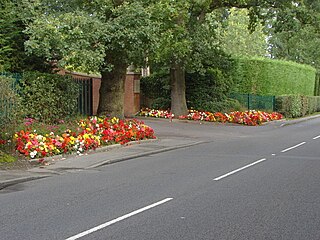
Windlesham Moor is a country house and, for a time in the 20th century a royal residence, at Windlesham in the English county of Surrey. In its capacity as a royal residence, it was, for nearly two years in the late 1940s, the home of Princess Elizabeth and her husband Philip, Duke of Edinburgh.
Innovia Films, a division of CCL Industries, is an international manufacturer and supplier of biaxially-oriented polypropylene (BOPP) films for speciality packaging, labelling, tobacco overwrap and industrial products. It was once known as UCB Films.

Badshot Lea is a small village in Surrey, England, and close to Aldershot. Badshot Lea has access in either direction to the A31 and A331 and is connected to railway stations in the nearby towns with regular bus services. The village is part of the Blackwater Valley or Aldershot Urban Area, the thirtieth largest conurbation in the UK. Badshot Lea's boundaries are four bridges—three western railway bridges and Pea Bridge over the uppermost part of the River Blackwater— these inspired a logo for the village and the football team who play in the larger neighbouring village of Ash. The Blackwater separates Badshot Lea from Aldershot to the north; the eastern and western boundaries are short and the southern boundary is the A331.

The A180 is a primary route in northern England, that runs from the M180 motorway to Cleethorpes. The road is a continuation of the M180, but built to lower specifications: it is mainly dual two-lane without hard shoulders. The road is dual carriageway for 16.87 miles (27.15 km) from the M180 to Grimsby, and is a single carriageway road for 2 miles (3.2 km) between Grimsby and Cleethorpes beach.
David Victor Canter is a psychologist. He began his career as an architectural psychologist studying the interactions between people and buildings, publishing and providing consultancy on the designs of offices, schools, prisons, housing and other building forms as well as exploring how people made sense of the large scale environment, notably cities. He set up the Journal of Environmental Psychology in 1980. His work in architecture led to studies of human reactions in fires and other emergencies. He wrote about investigative psychology in Britain. He helped police in 1985 on the Railway Rapist case. He was the professor of psychology at the University of Surrey for ten years, where he developed investigative psychology described in detail in Investigative Psychology: Offender Profiling and the Analysis of Criminal Action and a course curriculum. He set up and was director of the Centre For Investigative Psychology, which is based at the University of Liverpool. From 2009 he was at the University of Huddersfield, where he directed the International Research Centre in Investigative Psychology. He retired from there in 2018. He is emeritus professor at the University of Liverpool and continues to publish in environmental and crime/forensic psychology.

Trowell services is a motorway service station off the M1 motorway in Trowell, Nottinghamshire, England, situated north of Junction 25. Opened in 1967 by Mecca Leisure, it is currently owned by Moto. The services are situated near Nottingham.
Top of the Form was a BBC radio and television quiz show for teams from secondary schools in the United Kingdom which ran for 38 years, from 1948 to 1986.

Grantham North Services is a service area operated by Moto located on the A1 at Gonerby Moor Roundabout, four miles north of Grantham in Lincolnshire, England. The service station has a main car park and coach/lorry park, off which is a BP petrol station.
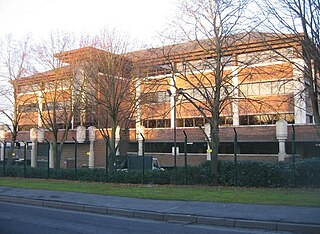
Norfolk House, in Basingstoke, Hampshire, England, was the headquarters of The Automobile Association from the mid-1990s until 2003. It was originally intended to replace Fanum House as the AA's HQ, but ultimately the building was not large enough to accommodate all Basingstoke-based employees and both buildings operated concurrently.
William Benyon is an English former professional rugby league footballer who played in the 1960s and 1970s, and coached in the 1970s, 1980s and 1990s. He played at representative level for Great Britain, England and Lancashire, and at club level for St Helens, Cronulla-Sutherland Sharks and Warrington, as a centre or stand-off, and coached at club level for St Helens and Leigh.
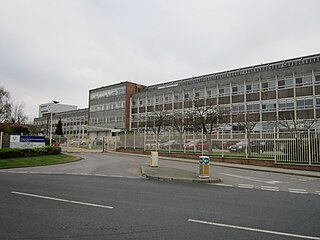
The Unilever Research & Development Port Sunlight Laboratory is the multinational consumer goods company Unilever's main research and development facility in the United Kingdom. It is located in Bebington, Merseyside.
The Sterling-Winthrop Research Centre was a research centre in Alnwick.

The Napp Research Centre is a large medical research institute in the north of Cambridge, and innovative-looking and award-winning architecture; it is a Cambridge landmark.

Aldershot Buddhist Centre is a Buddhist temple and community centre catering for the Buddhists of Aldershot in Hampshire and surrounding area. Opened in 2015, it describes itself as the United Kingdom's first Buddhist community centre.
The Institute of Naval Medicine is the main research centre and training facility of the Royal Navy Medical Service.
The Shell Technology Centre was a chemical and oil products research institute in northern Cheshire, near Stanlow, owned by Anglo-Dutch Shell.

Chesterford Park Research Station was a former crop protection research centre in Essex, and is now a science park with biotechnology companies.













